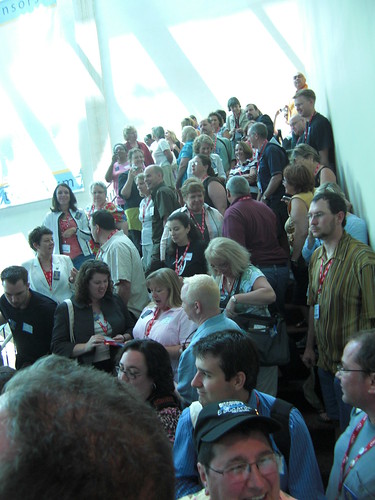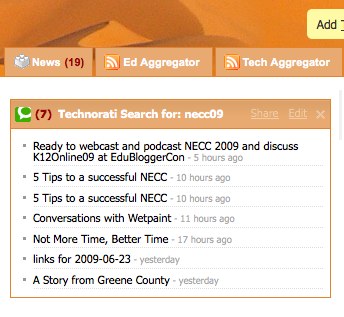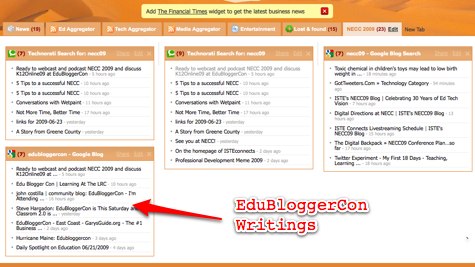 |
|
|
I wrote yesterday that if blogging…
…was, then blogging would be little more than a bunch of web pages posted on the Web — thousands per minute. There is some sophistication behind the simplicity of blogging that kicks up its value, especially when blogging around a common topic or experience.
No truer statement have I made, ’cause thar be magic in them thar hills. First, it should be no surprise that the blogosphere (where blogs live) can be searched. Google has an excellent and fairly thorough blog search engine, Google Blog Search. Or you can just go to Google, do your search for web sites, then click down the [more] menu and select [blog].
A search for necc09 reveals 3,701 blog posts that mention term, at the moment of this writing, sorted by relevance. I can click [Sort by date] in the upper right corner and get a list from the most recent – backward — topped by an entry posted nine minutes ago. A few minutes ago, I posted a tweet (more about tweeting in my next BloggingNECC post):
I wonder what it would be like to follow the “swarm” at NECC. Just go where others are going & not look at the program.
In a sense, this is what we can do, during and after the event — we can follow the swarm around by reading their notes, and even engaging the swarm through comments. Dave Sifry, the CEO of Technorati, says that “…the blogosphere is the exhaust of our attention streams.” We have never been able to do this before, take what you and I are paying attention to and lay it down onto the record. Sifry continues, “…they are a tangible reflection on what we are spending our time and attention on.” ((Sifry, David. “Oct 2004 State of the blogosphere: Big Media vs. Blogs.” [Weblog Sifry’s Alerts] 14 Oct 2004. Technorati, Inc. 23 Sep 2008 <http://www.sifry.com/alerts/archives/000247.html>. )) ..and it is recorded, accessible, and measurable — in some pretty astounding and revealing ways. But more on that later.
What we get from Google is blog postings that included necc09, which in this case is pretty useful. But if I go to Technorati and type the same thing, I get the 66 most recent blog posts. If I drop down the second menu in the search line, and select [tags only], I get the latest 26 blog posts where the blogger tagged or labeled their blog with necc09. If I drop down the third menu and select [some authority], we get, at this writing, the 22 most recent blog posts that mention necc09, written by bloggers who are respected by other bloggers. Your authority is measured by Technorati through the number of other bloggers who have linked to your blog. This is a bit of a slippery thing as there are lots of reasons why a blog may link to your blog. However, this appears to be reasonably reliable way of measuring a bloggers creds.
![]() The coolest part of all of this is a little symbol just above and to the right of the search results (see right). The symbol stands for RSS, which is usually translated into Really Simple Syndication. The original meaning is so esoterically technical that no one remembers what it is. As you move your mouse over the symbol, it turns into a button-clicking finger, meaning that it is a hyperlink to something. The address of the hyperlink is important. It is the RSS feed, and in this case, it looks like this:
The coolest part of all of this is a little symbol just above and to the right of the search results (see right). The symbol stands for RSS, which is usually translated into Really Simple Syndication. The original meaning is so esoterically technical that no one remembers what it is. As you move your mouse over the symbol, it turns into a button-clicking finger, meaning that it is a hyperlink to something. The address of the hyperlink is important. It is the RSS feed, and in this case, it looks like this:
http://feeds.technorati.com/search/necc09?type=search&authority=a4&language=n
 |
|
|
With this URL, you can do some pretty magical things. For instance, I can go to a web site called Netvibes, set up an account (click [signup]), create a new tab, called NECC 2009 (click [New Tab] and type NECC 2009), and then click [Add content] in red in the top left corner of the page. Click our RSS symbol, and paste the URL (above) into the appearing textbox. After a moment a small “FEED” box appears. We click [add], or drag the box into our window space, and presto (see left).
 |
|
|
We might go through the same process to list bloggers with any degree of authority and add a second box listing the latest blog entries. We could even drop back to Googles Blog Search, search again for NECC09, and get a reference to RSS in the left panel. Add that one in (see right).
The result is a single web page that we can visit to catch the latest that is being written about this year’s National Education Computing Conference, starting in three days in Washington.
If we are also interested in the happenings at the third annual EduBloggerCon, held on Saturday at the conference site, we can do a Google Blog Search for EduBloggerCon, move that RSS feed over to Netvibes, and we have added yet another box, the latest being written about the bloggers’ gathering (see below).
There are many tools similar to Netvibes, which are generically called aggregators or RSS readers. Here is a very limited list of free readers to choose from:
| Tool | URL | Instructions |
| Google Reader | http://google.com/reader | Here is a three part YouTube video series: part 1, part 2, (by Liz Davis) part 3 (GR in Plain English) |
| Bloglines | http://bloglines.com/ | YouTube video about setting up and using Bloglines from |
| Pageflakes | http://pageflakes.com/ | Another YouTube Video about setting up and using PageFlakes. |
| Netvibes | http://netvibes.com/ | A YouTube Video about setting up and using Netvibes. |
Most Browsers can also incorporate RSS feeds.
You can even geek this out and display RSS feeds on your web page or blog. Using Feed2JS, a tool, brilliantly coded by Alan Levine, we can generate a Java script, plug it into our web page (or blog entry) to generate a list of the 10 latest blog posts that mention edubloggercon. He has made his tool distributable, so here is the version on Landmarks for Schools.
This is magical, in my opinion. We are able to not only access flows of information, be actually redirect it, re-combine it, further working the information to make it more valuable and to improve our own capabilities. It turns an event, such as an education conference, into an explosion of knowledge and experiences. It’s how we learn in the 21st century.
It’s a huge part of how teachers teach!
Powered by ScribeFire.


One thought on “Gathering the Conversation at NECC”